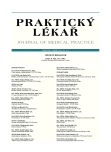Basics of cognitive, affective and social neuroscience:
VII. Lying
Authors:
F. Koukolík
Authors‘ workplace:
Primář: MUDr František Koukolík, DrSc.
; Národní referenční laboratoř prionových chorob
; Fakultní Thomayerova nemocnice s poliklinikou, Praha
; Oddělení patologie a molekulární medicíny
Published in:
Prakt. Lék. 2011; 91(7): 379-384
Category:
Editorial
Overview
To lie is to make a false statement with the intention to deceive. To deceive means to intentionally cause another person to have a false belief. To discover whether, or not a person is lying is difficult find, monitoring their nonverbal behaviour is of key importance. It requires experience and has its limits. Examination by polygraph has low sensitivity and specificity. Use of contemporary functional imaging methods has considerable limits too. The burden of these methods is connected with four types of problems including inner „self-defence“.
Key words:
lying, deceiving, polygraph, imaging methods.
Sources
1. Appelbaum, P.S. The new lie detectors: neuroscience, deception and the courts. Psychiatr. Serv. 2007, 58, p. 460-462.
2. Bizzi, E., Hyman, S.E., Raichle, M.E. et al. Using imaging to identify deceit. Scientific and ethical questions. Cambridge, MA: American Academy of Arts and Sciences, 2009.
3. Carrion, R.E., Keenan, J.P., Sebanz, N. A truth that´s told with bad intent: an ERP study of deception. Cognition 2010, 114, p. 105-110.
4. Green, J., Cohen, J. For the law, neuroscience changes nothing and everything. Phil. Trans. R. Soc. Lond. B. 2004, 359, p. 1775-1785.
5. Kahnwisher, N. The use of fMRI in lie detection: what has been shown and what has not. In: Bizzi E, Hyman SE, Raichle ME et al. Using imaging to identify deceit. Scientific and ethical questions. Cambridge, MA: American Academy of Arts and Sciences 2009, p. 7-13.
6. Karim, A.A., Schneider, M., Lotze, M. et al. The truth about lying: inhibition of the anterior prefrontal cortex improves deceptive behavior. Cerebral. Cortex. 2010, 20, p. 205-213.
7. Lee, L.M.C, Lee, T.M.Y, Raine, A. et al. Lying about valence of affective pictures: an fMRI study. 2010; PLoS ONE 5(8): e12291. doi:10.1371/journal.pone.0012291.
8. Mobbs, D., Lau, H.C., Jones, O.D. et al. Law, responsibility and the brain. 2007; PLoS Biol 5(4): e103. doi:10.1371/journal.pbio.0050103.
9. Morse, S.J. Culpability and control. Univ. PA Law Rev. 1994, 142, p. 1587-1660.
10. Morse, S.J. Actions speak louder than image. In: Bizzi E, Hyman SE, Raichle ME et al. Using imaging to identify deceit. Scientific and ethical questions. Cambridge, MA: American Academy of Arts and Sciences 2009, p. 23-34.
11. National Academy of Sciences. The polygraph and lie detection. Washington, DC: National Research Council 2003.
12. Phelps, E.A. Lying outside the laboratory: the impact of imagery and emotion on the neural circuitry of lie detection. Bizzi E, Hyman SE, Raichle ME et al. Using imaging to identify deceit. Scientific and ethical questions. Cambridge, MA: American Academy of Arts and Sciences 2009, p. 14-22.
13. Porter, S., Brinke, L. The truth about lies: what works in detecting high-stake deception? Legal and Criminological Psychology 2010, 15, p. 57-75.
14. Priori, A., Mameli, F., Cogimamian, F. et al. Lie-specific involvement of dorsolateral prefrontal cortex in deception. Cerebral Cortex 2008, 18, p. 451-455.
15. Sip, K.E., Roepstorff, A., McGregor, W. et al. Detecting deception: the scope and limits. Trends Cogn. Sci. 2007, 12, p. 48-53.
16. Spence, S.A., Hunter, M.D., Farrow, T.F.D. et al. A cognitive neurobiological account of deception: evidence from functional neuroimaging. Phil. Trans. R. Soc. Lond. B. 2004, 359, p. 1755-1762.
17. Spence, S.A. Playing Devil’s advocate: the case against fMRI lie detection. Legal and criminological psychology 2008, 13, p. 11-25.
18. Stanford Encyclopedia of Philosophy. The definition of lying and deception [on-line]. Dostupné na http://meinong.stanford.edu/entries/lying-definition.
19. Wu, D., Loke, Ch.I., Xu, F. et al. Neural correlates of evaluations of lying and truth-telling in different social context. Brain Res. 2011; doi:10.1016/j.brainres.2011.02.084.
Labels
General practitioner for children and adolescents General practitioner for adultsArticle was published in
General Practitioner

2011 Issue 7
Most read in this issue
- Cystic tumours of the pancreas – an up-to-date review
- Prenatal diagnostics of the most frequent chromosomal aberrations
- Acute endoscopic treatment of upper gastrointestinal bleeding: twenty-one-years experience
- The health risk of an excessive intake of fructose
